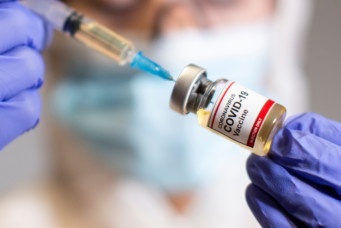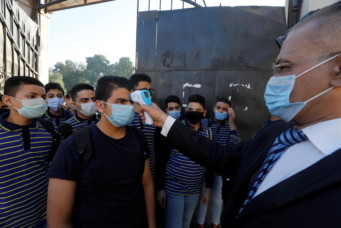COVID Vaccines for All?
Healthcare workers are still the best bet for increasing vaccine uptake, say behavioral economists.

For more than two years, people and governments around the world have witnessed an unprecedented health crisis—one resulting in severe economic, social, and clinical consequences. During this time, COVID-19 has forced governments across the world to enact strict restrictions on people’s physical colocation, including lockdowns and curfews, to contain the spread of the virus. The pandemic has already disrupted numerous economic indicators and social determinants of health, including economic safety, food security, home security, and educational opportunities. In this context, a successful global COVID vaccination program provides a unique opportunity to curb the development of new and dangerous coronavirus variants.
While enabling global vaccine equity—a just distribution of vaccines around the world that improves access for the most vulnerable people—is a foundational part of the overall strategy to tackle the pandemic, some efforts to make the vaccine widely available have proven unsuccessful in the absence of sufficient uptake by the population. This situation necessitates that healthcare policymakers across the world implement policies that ensure the accelerated adoption of COVID vaccines. This effort requires investing in communities and addressing logistical challenges that are currently impeding COVID vaccine distribution.
Worryingly, COVID vaccination rates remain low, especially in African countries. According to research from global management consulting firm McKinsey & Company, only one-fourth of the population is vaccinated with at least one dose on the continent, compared to almost 70 percent globally. These trends are increasing the epidemiological concern that unvaccinated populations could lead to the emergence of novel variants of the coronavirus, further complicating the public health response— especially in countries with low resources. Widespread misinformation about the adverse effects of vaccinations contributes to low vaccination rates. These concerns feed into a preexisting general lack of trust in governments. Therefore, the success of any vaccination campaign hinges on interventions that can help people understand the importance of their participation and improve trust in the vaccine’s safety and effectiveness. In addition to developing partnerships that promote vaccine equity, healthcare policymakers should support primary care providers such as frontline physicians, nurses, and allied health workers.
Frontline care providers are uniquely placed in the global healthcare delivery system as patients put considerable trust in them. Most patients reach out to their primary care providers before making any significant decisions regarding their health. These providers are also familiar with the health history of their patients and patients’ families including potential comorbidities that increase the risk of adverse outcomes should the patient or a member of their family be infected. They also play an important role as information intermediaries and decision support systems. They can interpret, document, and reiterate information about the safety and effectiveness of the COVID vaccine.
There is evidence that employing plain language in communicating public health information improves the adoption of the message. The role of primary care providers—and especially nurses and community health workers—is critical to declutter the information, distill the key messages, and interpret them for their patients. In their position of trusted advisors for their patients’ health, these providers can act proactively and participate in outreach initiatives to raise awareness among their patients of the availability of a safe and effective vaccine and its importance for public health. This is particularly important in underserved communities that exhibit lower trust in the healthcare system. At the individual patient-physician level, these providers can leverage communication strategies based on behavioral economics to improve vaccination rates.
To start with, behavioral economists have demonstrated the importance of “choice architecture” whereby structuring the context in which people make decisions nudges them toward certain choices. In a randomized trial, investigators reported that healthcare providers who, after reviewing the patient’s profile and vaccination status, simply announced that the patients were ready for vaccination observed an increase in vaccination uptake of over five percentage points more than providers who started a conversation about why they would recommend that the patient should consider vaccinating. Vaccination uptake was higher among patients who recalled the provider communicating efficiently versus those that remembered engaging in a conversation with them. Assertive statements help to reduce the ambiguity that patients often perceive when talking with medical experts, which can lead to doubt about the true importance of vaccinations. By stating that the patient is ready for vaccination, physicians exhibit trust in vaccine effectiveness and safety, which in turn will enable their patients to decide on actions that prevent illness and improve health.
Additional public policy solutions include incorporating behavioral mechanisms that foster individual contributions to public goods. To illustrate: in addition to pursuing their best personal interests, individuals are motivated by their concerns for social image—that is, beliefs about how members of their reference group perceive them. Their behaviors are shaped by norms that operate within such reference groups and define actions that are approved or disapproved by its members. Therefore, positioning participation in the vaccine campaign to contribute to the welfare of one’s community, in addition to ensuring personal protection from the virus, is likely to form or sustain an identity of a “good citizen.”
Public health policies also need to leverage effective messaging about the role that each individual plays in their community’s welfare. Social media influencers need to be engaged more than prominent politicians to increase the appeal of the vaccination campaigns and, at the same time, reduce their association with political division. It is important to produce a perception that vaccination is not only a desired behavior, but also a normal behavior exhibited by the members of our community of reference. The presence of an audience further strengthens these mechanisms. Evidence suggests that observability of contributions to a public good leads to higher levels of contributions, especially when the contribution is made through actions instead of monetary donations. Tokens of appreciation, thank you notes, celebrations, and stickers to mark having been vaccinated are simple but powerful ways to foster image motivation to contribute. Healthcare leaders need to dedicate institutional resources toward these initiatives.
In countries that have dedicated electronic health record systems, healthcare administrators and policymakers can also institute “design solutions” to supplement these care provider efforts. Innovative solutions include incorporating subtle reminders or “nudges” into health record systems. A recent study by researchers at the University of Pennsylvania demonstrated that flu vaccination rates increased by 9.5 percentage points within their primary care networks when an “active choice intervention”—an automated reminder for medical assistants to ask patients about their vaccination status during their initial visit—was implemented. Before the intervention, validation of the patient’s vaccination status relied on memory. In the later hours of their shift, when decision fatigue was more likely to ensue, instances of healthcare providers offering vaccination opportunities were less frequent. Implementing a relatively inexpensive mechanism to relieve the burden of active decision-making may prove instrumental in increasing participation in vaccination campaigns.
COVID-19 has brought to the forefront the importance of building robust and equitable public health systems. This pandemic has led to unimaginable societal and economic loss, mainly because of incomplete information and a lack of coordination and collaboration from national leaders. Now, with the availability of COVID vaccines, political leaders and health policymakers have an opportunity to change the trajectory of the pandemic and mitigate its impact by investing in system-level solutions to support care providers so that they can successfully guide their patients toward behaviors that promote health. Leveraging an array of solutions that have been shown to effectively influence individual behaviors represents a critical design element for a successful deployment of the ongoing vaccination campaign—one that could lead to safely navigating the new normal in people’s social and economic lives.
Junaid Nabi, MD, MPH, is a health systems researcher working at the intersection of health care reform and innovation. He is a senior fellow at the Aspen Institute and serves on the Working Group on Regulatory Considerations for Digital Health and Innovation at the World Health Organization. Twitter: @JunaidNabiMD.
Read More




